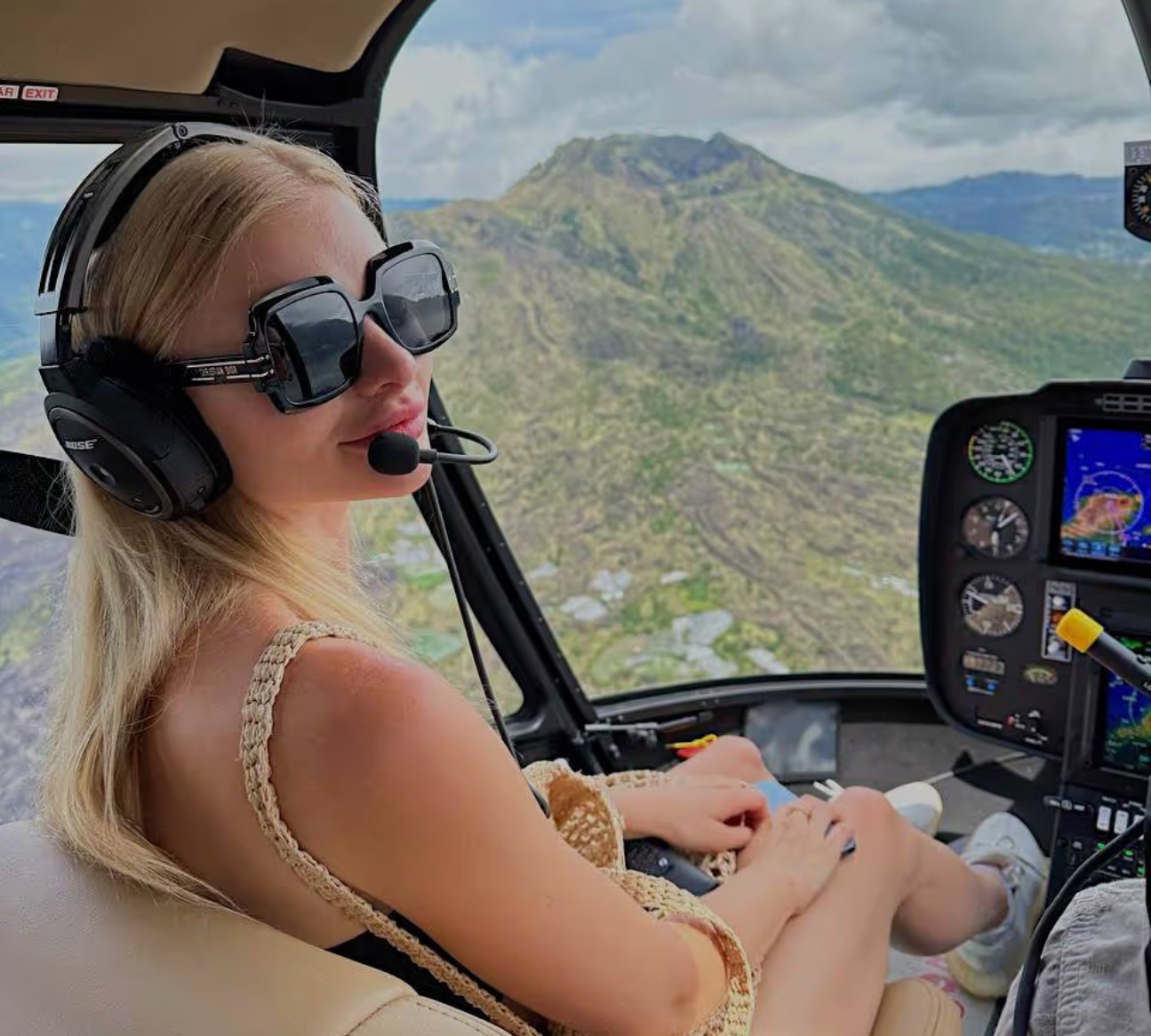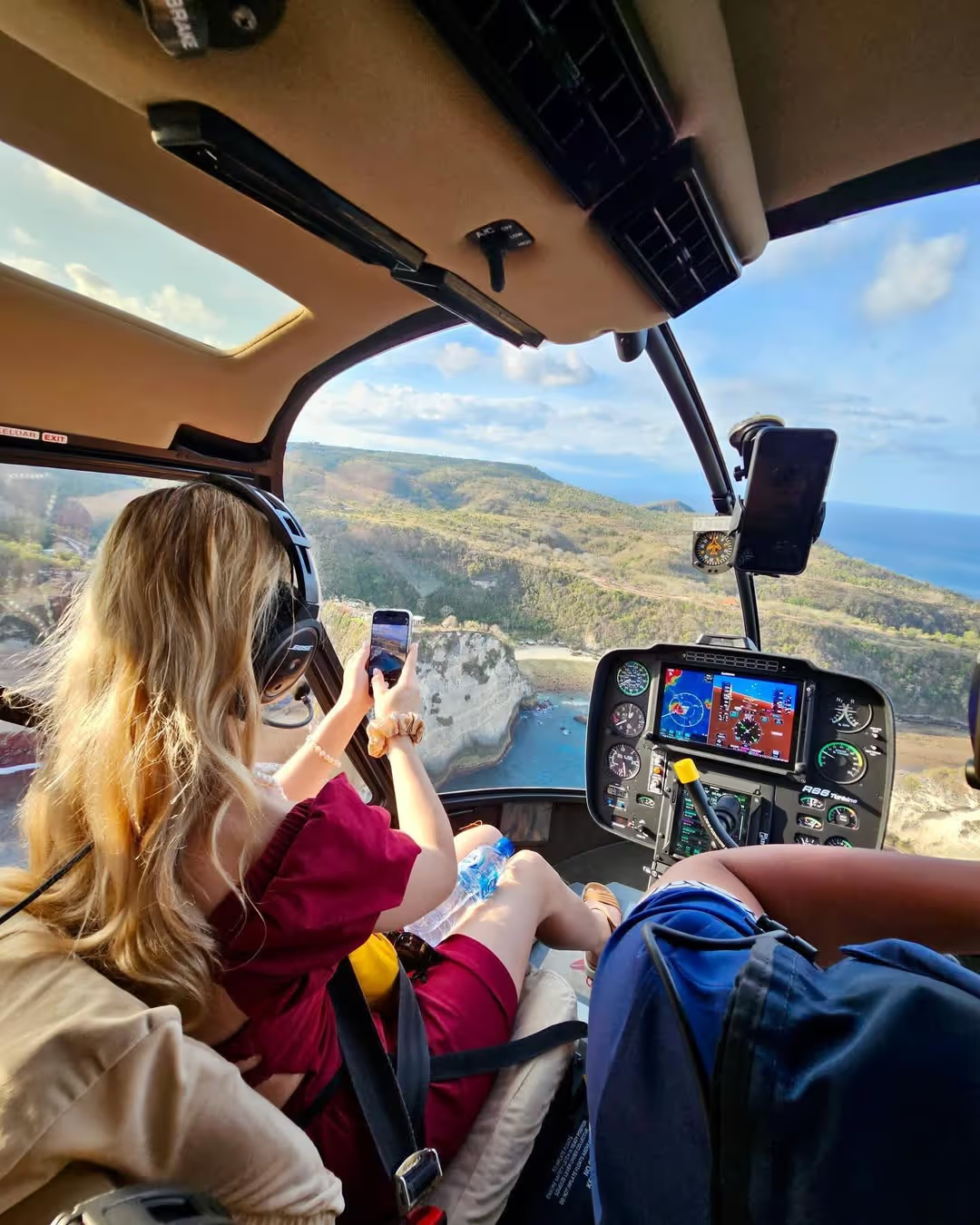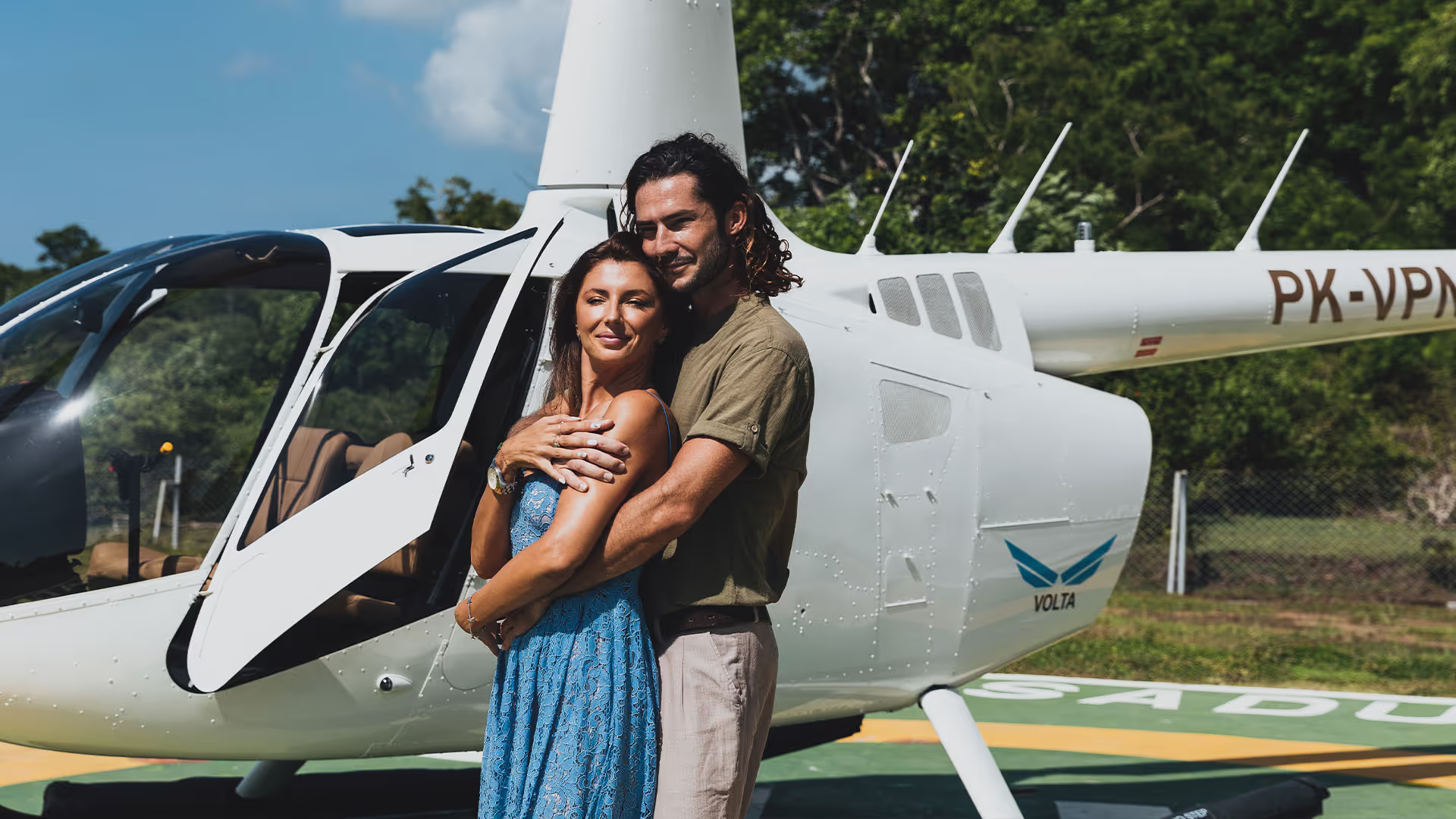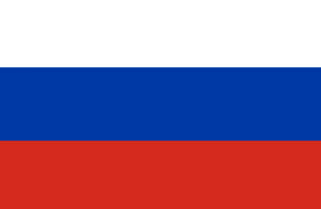Bali Helicopter Weather Guide: Best Seasons and Flight Conditions

Bali’s beauty from above depends on more than the helicopter you’re flying in — it depends on the sky itself. Sunshine, cloud cover, and the island’s shifting microclimates can completely change the view. One day the cliffs of Uluwatu are crisp and golden against a turquoise ocean; the next, sea haze softens the horizon and the temple looks like a silhouette in the mist.

Knowing when to fly is the difference between a nice ride and a breathtaking memory. In this guide, we’ll break down Bali’s dry and wet seasons, daily weather patterns, and the small but important microclimates that affect each route. You’ll also learn why pilots make last-minute “go or no-go” calls, and how to plan your trip with flexibility so you never miss your chance to see the island from above.
Dry vs Wet Season: What to Expect
Bali has two distinct weather seasons, and each shapes the helicopter experience in different ways.
Dry Season (April–October)
- Skies are usually clear, with long stretches of sunshine.
- Visibility is excellent — you can often see all the way from the Bukit Peninsula to Mount Agung or even Lombok on the horizon.
- Winds are steady but mild, making flights smoother.
- This is the prime season for aerial photography, especially along Bali’s south and west coasts.

Wet Season (November–March)
- Expect higher humidity and sudden tropical showers, especially in the afternoons.
- Mornings are often clear, but clouds build quickly by midday.
- Flights may be rescheduled more frequently due to rain or reduced visibility — a normal safety measure.
- The advantage: after rain, the landscape looks especially lush, and the ocean colors can pop dramatically against dark skies.
Takeaway: You can fly in both seasons, but the dry months offer the most reliability. If you’re visiting during the wet season, aim for early-morning flights to maximize your chances of a clear view.
Daily Weather Patterns
Bali’s weather shifts not only by season but by time of day. Understanding these patterns helps you pick the slot that matches your priorities — whether that’s clear skies, soft light, or dramatic colors.

Morning Flights (9–11 am)
- The calmest and clearest window of the day.
- Winds are light, clouds haven’t yet formed, and the air feels crisp.
- Best choice if you want guaranteed visibility of coastlines, volcanoes, or distant islands.
- Photos come out bright and colorful, with minimal haze.
Midday Flights (12–2 pm)
- Stronger sunlight means high contrast and more glare off the ocean.
- Great for seeing detail in the water — reefs, sandbars, and shallow lagoons glow in midday light.
- The heat is at its peak, and turbulence can be slightly stronger near cliffs.
Afternoon Flights (3–5 pm)
- Known as the “golden hour” for photography.
- The cliffs of Uluwatu glow warm orange, and long shadows add drama to the coastline.
- However, by this time of day clouds and humidity are more likely to build up, especially in the wet season.
- Excellent for romantic or dramatic flights, but with a higher chance of weather-related delays.
In short:
- Choose morning for clarity.
- Choose midday for vivid ocean colors.
- Choose afternoon for atmosphere and golden light.
Microclimates Around the Island
Bali may look small on a map, but its landscapes create sharp variations in weather within short distances. For helicopter tours, these microclimates matter — they shape what you’ll see in the air.

Bukit Peninsula (Uluwatu, Melasti, Pandawa)

- The southern cliffs are exposed to open ocean winds.
- Morning flights are usually clear, but by afternoon a fine sea haze can soften the view.
- Dramatic waves against the cliffs are most visible when winds pick up, adding energy to photos.
West Coast (Tanah Lot, Canggu, Seminyak, Kuta)

- This stretch benefits from more even weather, with long surf lines and open horizons.
- Afternoon can bring coastal cloud cover, especially in the wet season, but it rarely obscures the main landmarks.
- Sunsets here are famous, though flights typically finish before dark.
Volcano Routes (Mount Batur, Mount Rinjani)

- These areas are the most weather-sensitive. Clouds form quickly around high peaks, especially after midday.
- Early-morning flights (before 10 am) are almost always recommended for volcano routes.
- The payoff is spectacular: if the sky is clear, you’ll see Bali’s mountains rising above a sea of clouds.
In short, each corner of the island has its quirks. The coastlines are flexible year-round, but volcano routes demand early starts and dry-season planning.
How Pilots Decide: Go/No-Go Factors

Every helicopter flight in Bali is cleared not just by the booking team but by the pilot on duty. Safety is non-negotiable, and weather is the number one deciding factor. Here’s how those calls are made:
Cloud cover
- Pilots need clear visibility along the route and around landing zones. Low or fast-moving clouds near cliffs or volcanoes are an immediate red flag.
Rain and thunderstorms
- Light drizzle isn’t always a problem, but heavy rain or electrical activity means no flight. In the tropics, storms can form quickly, so pilots stay in close contact with weather stations.
Wind conditions
- Strong gusts or crosswinds near cliffs like Uluwatu can make flying uncomfortable or unsafe. Pilots monitor both wind speed and direction before takeoff.
Visibility range
- Clear sightlines are essential not only for passenger experience but also for safe navigation. If haze, smoke, or heavy cloud drops visibility below limits, flights are delayed.
Final authority
- The captain’s word is final. Even if skies look clear from the ground, pilots may cancel based on data from radar or air traffic control. This system ensures that every flight is conducted under safe conditions.
What this means for travelers
- If your flight is postponed or canceled, it’s not a loss — it’s a sign that safety comes first. Balicopter’s policy guarantees rescheduling or full refunds, so you never take on the risk.
Best Time of Year for Specific Routes

Different helicopter tours across Bali interact with weather in their own way. Knowing the seasonal sweet spots helps you pick the right flight for the right time of year.
South Bali Tours (10 & 15 minutes — Nusa Dua)
- Reliable almost year-round.
- Clear mornings in both dry and wet season show off GWK, Melasti, and Pandawa at their best.
- Afternoon flights are stunning in dry season (golden light on the cliffs), but haze is more common in the wet months.
Canggu & Uluwatu Tour (35 minutes — Canggu/Nuanu)
- Longer route means more exposure to shifting weather.
- Dry season (April–October) is ideal: wide horizons let you see both coastlines in full clarity.
- Wet season flights are still possible, but clouds may reduce visibility over the western beaches. Mornings are safer for clear skies.
Volcano Tours (Mount Batur, Mount Rinjani, or Ijen)
- Highly weather-dependent.
- Best in the dry season, especially from June to September when skies are clearest.
- Flights should always be scheduled in the early morning — by midday, volcano peaks are often shrouded in cloud.
- The reward: sunrise light over volcano craters, often above a blanket of mist.
Takeaway:
- Coastline flights work almost any time of year, with dry season adding extra clarity.
- Volcano routes are a “dry season + early morning” experience for the best odds of success.
Tips for Travelers

Flying in Bali is about more than booking a seat — it’s about planning smartly so the weather works in your favor. Here are key tips to make sure your tour goes smoothly.
1. Book early in your trip
Schedule your helicopter tour for the first or second day of your holiday. This way, if the weather forces a reschedule, you still have flexibility later in your stay.
2. Aim for mornings
The clearest skies and calmest winds are usually between 9 and 11 am. Afternoon flights are beautiful but carry more risk of cloud build-up, especially in the wet season.
3. Leave buffer days
If you’re traveling during Bali’s rainy months (November–March), allow at least one extra day as a backup. This dramatically increases your chance of flying without stress.
4. Dress for comfort and photos
Light clothing, sunglasses, and secure straps for cameras/phones are essential. Avoid bright white clothing to reduce reflections in photos.
5. Trust the pilot’s call
If a flight is canceled or postponed, it’s for safety. Balicopter guarantees either a rescheduled slot or a full refund — so you never lose out.
6. Combine with special occasions
If you’re planning a proposal, birthday, or family celebration, build in weather flexibility. A morning slot with a backup day ensures your big moment isn’t spoiled by rain.
7. Know the refund policy
Every booking comes with instant confirmation and a “Cancel anytime — 100% refund” guarantee, giving you peace of mind no matter what the forecast says.
FAQ: Most Common Questions About Weather and Flights
Do helicopter tours still run during the rainy season?
Yes. Flights operate year-round, but in the wet season (November–March) most tours are scheduled for the morning, when skies are clearer. Afternoon flights are more likely to be rescheduled.
What happens if my flight is canceled because of weather?
If conditions are unsafe, your flight will either be rescheduled or fully refunded. Balicopter’s “Cancel anytime — 100% refund” policy applies to weather-related cancellations too.
When is the best season for a helicopter ride in Bali?
The dry season (April–October) is the most reliable, with clear skies and stable winds. However, mornings in the wet season can still be excellent for short flights over South Bali.
Can I choose a sunset flight?
Helicopter tours usually end before dark for safety reasons. Late afternoon flights (around 4–5 pm) give you golden light over the cliffs, which is the next best thing to sunset.
Are volcano flights possible all year?
Yes, but the best time is in the dry season, early in the morning. Cloud build-up often covers peaks like Mount Batur or Rinjani by midday.
Should I check the forecast myself before booking?
It’s useful, but not essential. Pilots and ground staff track live weather data. Even if the forecast looks clear, the final decision rests with the pilot on the day of your flight.
Conclusion
Weather is the single factor that can turn a good helicopter ride into a once-in-a-lifetime experience. Clear skies, soft morning light, or golden afternoon glow — each creates a different memory of Bali from above. By understanding the island’s seasons and daily patterns, you can plan smarter: book early in your trip, aim for mornings, and leave flexibility in your schedule.
Whether you choose a quick 10-minute hop over South Bali, a 15-minute circuit of Uluwatu Temple, or the full 35-minute panorama linking two coastlines, the reward is the same: Bali’s cliffs, temples, and turquoise bays seen in their best light.
👉 Ready to plan your flight around Bali’s skies?
- South Bali Helicopter Tour — 10 Minutes
- Uluwatu Helicopter Tour — 15 Minutes
- Canggu & Uluwatu: A Tale of Two Coastlines — 35 Minutes
Don’t just visit Bali — fly above it. The weather will do the rest.
See more












.svg)
.svg)
.svg)